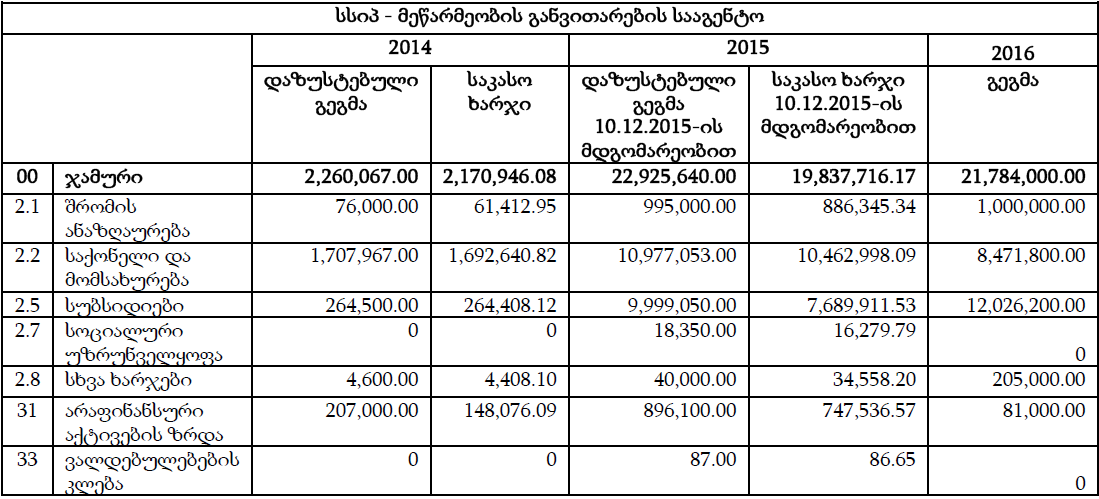On air on Imedi TV, the member of the United National Movement, Mikheil Machavariani, stated that Georgia is poorer today than it was three years ago as the GDP of the country was up to USD 16 billion at that time whilst today it is about USD 14 billion. As a response to this statement, the Prime Minister of Georgia, Giorgi Kvirikashvili, pointed out that in order to assess the size of the country’s economy and compare it with those of others, it is more appropriate to use the International Monetary Fund’s comparison of GDPs by Purchasing Power Parity (PPP) according to which the GDP of Georgia grew by 15% in 2015 as compared to 2012.
FactCheckverified the accuracy of the statements made by Mikheil Machavariani and Giorgi Kvirikashvili.
The poverty and welfare of a country are relative concepts. For example, Georgia is poorer than the member states of the European Union, the United States, Japan and Singapore whilst it is wealthier than Somalia, Liberia, Afghanistan, Kyrgyzstan and Pakistan. The wealth of a country is determined both by its GDP as well as by the number of its population. The size of the economy is the amount of income received by the population on the territory of the country within one year. Naturally, the more people share this income, the less the amount designated for one person will be.
As his main argument for proving that Georgia has become poorer, Mikheil Machavariani uses that fact that the GDP of Georgia in USD has decreased. The GDP of Georgia was USD 15.8 billion in 2012 whilst the forecast amount of the 2015 GDP is USD 13.8 billion. The decrease in the GDP of Georgia in USD was due to the depreciation of GEL whilst in real prices the GDP of Georgia in GEL has increased by 11% (GEL 2.6 billion). This amount (counted in real prices) is the actual indication of economic growth and not the growth calculated in nominal prices or in USD.
According to the International Monetary Fund, the GDP per capita in real prices was GEL 6,800 (USD 4,130) in 2012 whilst the forecast amount for 2015 is GEL 8,350 (USD 3,720). The International Monetary Fund corrected the data of the Georgian population from 2003 to 2013 according to the 2014 universal population census and took the drop in the Georgian population into account in its studies.
In order to find out whether or not Georgia has become poorer for the past three years, we looked at the positions it held in world rankings by the size of its economy as well as by GDP per capita. In our comparison, we used the data of the nominal GDP in USD as well as the GDP calculated according to Purchasing Power Parity (PPP). However, to make a comparison about how poor or wealthy the country has become, it is more appropriate to use the Purchasing Power Parity as pointed out by Mr Kvirikashvili. The methodology considers the income of the country by its purchasing power. As the prices of production in low-income countries is always lower than in most of the high-income countries, the purchasing power of their income is almost always much higher. Georgia is among such countries. According to the International Monetary Fund, even though in 2012 the nominal GDP per capita of Georgia was USD 4,434, its purchasing power was equal to that of USD 9,209. This means that if we spent USD 9,209 for certain products in the USA, in Georgia we would need USD 4,434 to buy the same production. In 2015, the GDP per capita by Georgia’s Purchasing Power Parity increased to USD 9,566.
Chart 1:Georgia in the World Economy by GDP
Source:International Monetary Fund
Chart 1 makes clear that Georgia’s position by nominal GDP as well as by GDP calculated by Purchasing Power Parity kept improving from 2003 to 2012 whilst in the past three years the positions have worsened. It should also be noted that Georgia’s GDP by Purchasing Power Parity has increased by 15% for 2015 as compared to 2012, as stated by the Prime Minister. The worsening of the position was due to the faster pace of economic growth in other countries over the past three years as compared to Georgia.
As pointed out earlier, a country’s wealth or poverty depends not only upon its GDP but the number of its population as well, or, in other words, on the country’s GDP per capita. Given the fact that the number of Georgia’s population is decreasing each year, its GDP per capita increases faster than it would in terms of its economic growth alone.
Chart 2:Georgia in the World Economy by GDP Per Capita
Source:International Monetary Fund
Chart 2 makes it clear that Georgia’s position in the world by nominal GDP per capita as well as GDP per capita by Purchasing Power Parity kept improving from 2004 to 2012. Compared to 2012, however, Georgia’s nominal GDP per capita position worsened in 2015 whilst its position of GDP per capita by Purchasing Power Parity improved by one unit.
Conclusion
A country’s economic growth is determined by the growth of its real GDP in the national currency. Georgia’s average economic growth rate from 2013 to 2015 was 3.6% and the economy increased by about 11% in three years. However, the fact that the growth rate decreased must also be taken into account. The country’s average economic growth rate was 6.6% from 2010 to 2012 and its economy increased by 21% in those three years.
Giorgi Kvirikashvili correctly indicates the appropriate methodology for comparing Georgia to other countries. The country’s GDP by Purchasing Power Parity as well as its GDP per capita by Purchasing Power Parity must be compared to those of other countries. Georgia’s positions by GDP size as well as by GDP per capita kept improving from 2004 to 2012 which means that its wealth increased. However, even this methodology does not show that the country became wealthier from 2013 to 2015 as stated by Giorgi Kvirikashvili. Georgia’s position in the world ranking by the GDP calculated by Purchasing Power Parity worsened by three whilst it improved by one in GDP per capita by Purchasing Power Parity. This improvement was due to the decrease in the number of the population. In fact, we can say that Georgia has been at a standstill for three years and has not become wealthier.
Hence,FactCheckconcludes that Mikheil Machavariani’s statement that Georgia has become poorer as the GDP in USD decreased isMOSTLY FALSEwhilst Giorgi Kvirikashvili’s statement isHALFTRUE.










